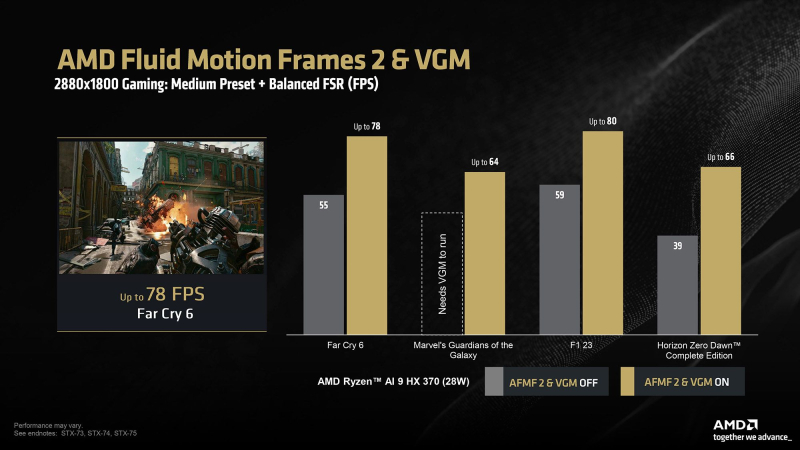AMD has released a preview of a graphics driver that supports AMD Fluid Motion Frames 2 (AFMF2) frame generation technology for the integrated RDNA 3.5 graphics of Ryzen AI 300 (Strix Point) mobile processors.

Image source: AMD
In addition to AFMF2 support for the Ryzen AI 300, the preview driver includes new Variable Graphics Memory (VGM) technology. Like AFMF2, it is designed to increase the performance of RDNA 3.5 graphics. VGM technology allows you to allocate up to 75% of the system RAM to the processors’ integrated graphics.
AMD urges people not to confuse the new VGM technology with shared graphics memory technology. After enabling the VGM function in the driver settings, you will need to reboot the system. By default, the allocated memory for integrated graphics is 512 MB. When using VGM, the company advises leaving at least 16 GB of RAM for CPU needs.

For systems with a large amount of RAM, for example 32 GB, the VGM settings can be set to “medium”, allocate 8 GB of RAM from this amount of RAM and convert them to VRAM. After rebooting the system, the integrated graphics of the Radeon 890M will be allocated not 512 MB, but 7.5 GB of VRAM.

It should be noted that VRAM configuration varies by system. Asus ROG Ally consoles, for example, have 4 GB of VRAM allocated for “built-in” by default, the volume of which can be increased to 8 GB, even though the console itself has only 16 GB of RAM. AMD does not limit the choice of memory size for VGM. The only condition is that this amount should not exceed 75% of the available RAM. For example, on systems with 32 GB of RAM, up to 24 GB of memory can be allocated for VRAM. True, in this case one should hardly expect positive results related to performance due to the small amount of remaining RAM.

AMD shared examples of benchmark tests with AFMF2 and VGM enabled in combination with FSR as part of HYPR-RX. Tests were conducted on the integrated Radeon 890M graphics of the Ryzen AI 9 370HX processor with a TDP of 28 W in the Asus Zenbook S16 laptop. At 1080p resolution and using FSR, the combination of AFMF2 and VGM technologies can achieve 90 fps in games such as Far Cry 6, Horizon Zero Dawn Complete Edition, F1 23 and Marvel’s Guardians of the Galaxy.

At a resolution of 2880 x 1800 pixels using medium graphics quality settings, you can expect up to 78 frames per second from Far Cry 6, and up to 66 frames per second from Horizon Zero Dawn. Of course, we are not talking about the native resolution, but about the FSR settings in the “Balance” mode. Despite this, the result is impressive, since we are talking about integrated graphics.
AMD also announced that adding VGM support is not planned for the integrated graphics of previous generation Phoenix and Hawk Point processors, as this would require firmware rework. Thus, the technology will not appear on processors combining Zen 4 computing cores and RDNA 3 graphics cores.
A preview version of the Radeon driver with AMD Fluid Motion Frames 2 (AFMF2) and VGM technologies for integrated graphics of Ryzen AI 300 processors can be downloaded from the official AMD website.